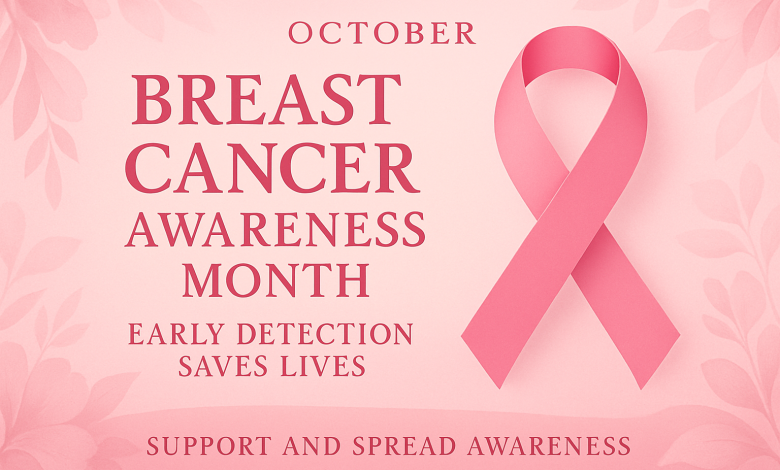Breast Cancer Awareness Month 2025: Surprising Facts That Could Save a Life

Introduction
Every October, millions of people worldwide unite for Breast Cancer Awareness Month, a time dedicated to spreading knowledge, encouraging early detection, and supporting ongoing research. As we move into Breast Cancer Awareness Month 2025, it’s important to not only raise awareness but also uncover surprising, sometimes overlooked facts about breast cancer that truly have the potential to save lives.
While pink ribbons, walks, and campaigns dominate this month, the conversation must go beyond symbolism. Today, breakthroughs in screening, lifestyle understanding, genetics, and even technology are transforming how we fight breast cancer. Many of these facts are not widely known, yet they hold life-saving potential when applied in everyday life.
We’ll explore Breast Cancer Awareness Month 2025 through a new lens—one that reveals unexpected truths, practical prevention strategies, and the latest advances in treatment and detection.
Why Breast Cancer Awareness Month 2025 Matters More Than Ever
Breast cancer remains the most common cancer in women worldwide. According to the World Health Organization (WHO), it surpassed lung cancer in 2020 as the most diagnosed cancer globally. Despite improved survival rates, early detection and awareness remain the strongest weapons in reducing mortality.
In 2025, awareness campaigns are more than reminders—they are life-saving tools. With evolving risk factors, such as environmental exposures, sedentary lifestyles, and genetic vulnerabilities, education is crucial. Breast Cancer Awareness Month 2025 emphasizes not just awareness but actionable steps for prevention, screening, and treatment.
Surprising Facts About Breast Cancer That Could Save a Life
1. Breast Cancer Is Not Just a Women’s Disease
Most people believe breast cancer only affects women, but men can also develop it. In fact, about 1 in 833 men will be diagnosed with breast cancer in their lifetime. The stigma often delays diagnosis in men, making awareness critical for both genders.
2. Early Detection Isn’t Just Mammograms
Mammograms are the gold standard, but new screening technologies like 3D mammography (tomosynthesis), breast MRI, and molecular breast imaging are enhancing detection, especially for women with dense breasts. By Breast Cancer Awareness Month 2025, more clinics are adopting AI-assisted imaging, reducing false negatives and catching cancers earlier.
3. Dense Breast Tissue Increases Risk
Women with dense breast tissue have a higher risk of breast cancer and a harder time detecting tumors via traditional mammograms. Many women don’t know their breast density, yet it’s a key risk factor. Doctors now recommend additional screening if density is high.
4. Lifestyle Plays a Bigger Role Than Genetics
While the BRCA1 and BRCA2 gene mutations dramatically increase breast cancer risk, they only account for about 5–10% of cases. Surprisingly, 90–95% of breast cancers are influenced by lifestyle and environmental factors such as diet, alcohol, exercise, and exposure to chemicals.
5. Obesity After Menopause Raises Risk Significantly
Postmenopausal women who are overweight or obese face up to a 40% higher risk of developing breast cancer compared to those at a healthy weight. Excess fat produces more estrogen, fueling hormone-sensitive cancers.
6. Breastfeeding Can Lower Risk
Breastfeeding for a total of one year or more across pregnancies is linked to a 4–5% lower risk of breast cancer. The protective effect comes from hormonal changes that delay periods and reduce lifetime estrogen exposure.
7. Menstrual and Reproductive History Shapes Risk
Women who start menstruating early (before 12) or go through menopause late (after 55) are at increased risk due to longer lifetime estrogen exposure. Similarly, women who never give birth or have their first child after 30 face higher risks.
8. Alcohol Is a Known Risk Factor
Even moderate alcohol consumption—just three drinks per week—increases breast cancer risk by 15%. This fact surprises many, as alcohol’s role in cancer is often underestimated.
9. Exercise Is a Natural Protector
Regular physical activity reduces breast cancer risk by up to 25%. Exercise regulates hormones, boosts immunity, and reduces inflammation. Just 150 minutes of moderate activity per week can be life-saving.
10. Not All Breast Lumps Are Cancerous
Finding a lump can be terrifying, but 8 out of 10 breast lumps are benign. However, all lumps should still be checked by a doctor. Awareness campaigns in 2025 stress both vigilance and reassurance.
11. Vitamin D May Play a Protective Role
Studies suggest that higher levels of vitamin D are associated with lower breast cancer risk. Sunlight, supplements, and fortified foods may contribute to protection, though more research is underway.
12. Breast Cancer Can Be Silent
Not all breast cancers present with lumps. Some show up as skin dimpling, nipple changes, swelling, or redness. Awareness of these subtle signs can lead to earlier diagnoses.
13. Survival Rates Are Higher Than Most People Think
When detected early, breast cancer has a 5-year survival rate of over 90%. This fact reinforces the importance of screenings and self-awareness emphasized during Breast Cancer Awareness Month 2025.
Technological Advances in Breast Cancer Detection (2025 Edition)
AI and Machine Learning
Artificial intelligence is now assisting radiologists in reading mammograms, reducing human error, and detecting tumors invisible to the naked eye.
Blood Tests for Early Detection
So-called liquid biopsies are emerging as a promising tool. These blood tests can detect tumor DNA fragments long before a tumor is visible on imaging.
Personalized Screening Schedules
Instead of the one-size-fits-all model, genetic testing and risk calculators are helping design individualized screening timelines, making detection more precise.
The Role of Genetics in Breast Cancer
While most breast cancers aren’t inherited, genetic testing has become more accessible in 2025. Women with a family history of breast or ovarian cancer are encouraged to test for BRCA1, BRCA2, and other mutations like PALB2 and CHEK2. Preventive surgeries, medications, and intensified screening save lives in high-risk individuals.
Treatment Advances in 2025
Targeted Therapy
Medications like PARP inhibitors and HER2-targeted drugs are offering better outcomes with fewer side effects than traditional chemotherapy.
Immunotherapy
Harnessing the immune system to fight breast cancer is becoming a reality, with FDA-approved immunotherapies available for certain subtypes.
Personalized Medicine
Tumor profiling in 2025 allows doctors to tailor treatments based on an individual’s tumor genetics, maximizing effectiveness.
Myths vs. Facts About Breast Cancer
- Myth: Only women with a family history get breast cancer.
Fact: Most cases occur in women with no family history. - Myth: Wearing a bra or using deodorant causes breast cancer.
Fact: There is no scientific evidence supporting this. - Myth: Young women don’t need to worry.
Fact: While risk increases with age, breast cancer can occur in women in their 20s and 30s. - Myth: If you have no symptoms, you don’t need screening.
Fact: Many breast cancers are asymptomatic in early stages, making regular screening vital.
How to Take Action During Breast Cancer Awareness Month 2025
- Schedule a Screening – Book your mammogram or encourage loved ones to do so.
- Know Your Risk – Assess family history and lifestyle factors.
- Support Research – Donate to organizations funding innovative treatments.
- Educate Others – Share life-saving facts on social media.
- Adopt Healthy Habits – Exercise, eat well, and limit alcohol.
- Advocate for Equal Access – Support initiatives providing affordable screenings in underserved communities.
Global Initiatives for Breast Cancer Awareness Month 2025
Around the world, campaigns are growing stronger:
- United States: Expanded insurance coverage for 3D mammograms.
- Europe: Nationwide education programs on breast density.
- Asia: Mobile screening units in rural areas.
- Africa: Grassroots campaigns focusing on early detection in underserved populations.
These global initiatives highlight the universal importance of awareness and action.
Conclusion:
Breast Cancer Awareness Month 2025 is more than a campaign; it is a movement that saves lives through knowledge, early action, and research. From surprising lifestyle links to breakthrough detection methods, the facts highlighted here show that awareness is not just symbolic—it is practical, actionable, and vital.
Whether you’re scheduling your screening, making a healthier lifestyle choice, or spreading these facts to loved ones, you’re participating in a global effort to reduce the burden of breast cancer. Awareness, after all, is the first step toward prevention and survival.
By embracing the surprising facts of 2025 and sharing them widely, we can help ensure that fewer lives are lost to breast cancer in the future.



